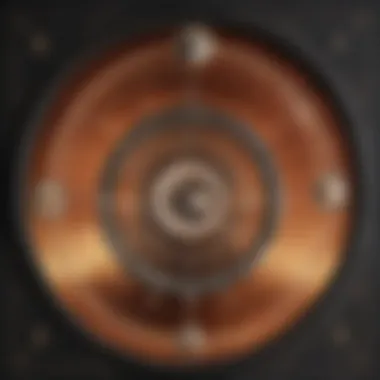Unlocking Relationship Dynamics Through Couple Astrology


Intro
Astrology offers a unique lens through which we can examine human relationships. Within this framework, couple astrology charts serve as a tool for understanding the dynamics that govern partnerships. This exploration dives into the intricacies of these charts, highlighting the importance of individual birth charts and how they interact with one another. Each zodiac sign has specific traits, and when two charts are compared, fascinating insights into strengths and challenges are revealed. This article provides a pathway for interpreting these charts, allowing readers to appreciate how astrology can facilitate personal growth and enhance connections.
Understanding the Zodiac
Overview of Zodiac Signs
The zodiac consists of twelve signs, each representing different personality traits and characteristics. These signs are Aries, Taurus, Gemini, Cancer, Leo, Virgo, Libra, Scorpio, Sagittarius, Capricorn, Aquarius, and Pisces. Each sign holds unique energy, which influences how individuals relate to one another in romantic partnerships. Understanding these signs is essential for interpreting compatibility.
Sign Traits and Characteristics
Every zodiac sign possesses distinct traits that shape the personality of individuals born under them. For instance, Aries is often seen as adventurous and assertive, while Cancer might be more nurturing and emotional. These traits play a significant role in how partners communicate and connect.
- Aries: Bold, competitive, and spontaneous.
- Taurus: Stable, practical, and reliable.
- Gemini: Curious, adaptable, and communicative.
- Cancer: Intuitive, emotional, and caring.
- Leo: Charismatic, confident, and generous.
- Virgo: Detail-oriented, analytical, and modest.
- Libra: Diplomatic, social, and peace-loving.
- Scorpio: Passionate, intense, and secretive.
- Sagittarius: Adventurous, independent, and optimistic.
- Capricorn: Disciplined, ambitious, and patient.
- Aquarius: Innovative, intellectual, and humanitarian.
- Pisces: Creative, empathetic, and sensitive.
This list illustrates the diverse ways people express their innate characteristics. When exploring couple astrology, identifying these traits is crucial for assessing compatibility.
Elemental Qualities
Each sign belongs to one of four elements—fire, earth, air, and water. These elements further define the fundamental nature of the signs and affect how individuals interact:
- Fire (Aries, Leo, Sagittarius): Energetic and passionate individuals.
- Earth (Taurus, Virgo, Capricorn): Grounded and practical personalities.
- Air (Gemini, Libra, Aquarius): Intellectual and communicative natures.
- Water (Cancer, Scorpio, Pisces): Emotional and intuitive beings.
Understanding elemental qualities aids in identifying the natural chemistry between partners. For example, fire and air typically thrive in their interactions, sparking creativity and excitement.
Astrological Insights
Current Astrological Trends
Astrology is not static; it evolves with celestial movements. Current trends indicate changing dynamics influenced by planetary alignments. Tracking these trends can help couples navigate their relationships more effectively according to the energies at play.
Influence of Celestial Events
Celestial events such as eclipses, retrogrades, and transits can significantly impact relationships. Being aware of these movements can provide insights into potential challenges or opportunities for growth. For instance, Mercury retrograde often invites communication issues, making it essential for couples to be mindful during these periods.
How to Interpret Your Birth Chart
Interpreting a birth chart involves looking at the sun, moon, and rising signs of both partners. This analysis reveals not only individual strengths but also how these traits influence the dynamics of the relationship. A successful interpretation incorporates understanding the aspects—angles formed between planets—that shape interactions.
Understanding Couple Astrology Charts
Couple astrology charts offer an intricate lens through which one can examine the dynamics of romantic relationships. This field explores how the celestial placements at the time of birth for two individuals can significantly affect their compatibility. In this article, we will outline the fundamental components of couple astrology charts, their importance, and how they can be interpreted to gain insights into relationship management.
Defining Couple Astrology
Couple astrology is the practice of comparing and analyzing the birth charts of two individuals to elucidate their relational harmony or discord. This involves a careful examination of both partners' celestial maps. Every person has a birth chart, which is essentially a snapshot of the sky at the moment of their birth. The positions of planets, the sun, and the moon are believed to influence personality traits, emotional responses, and interpersonal dynamics.
Understanding couple astrology necessitates looking beyond mere sun signs. It incorporates the moon signs, rising signs, and other planetary positions. By evaluating these elements, astrologers can determine not just basic compatibility but also deeper emotional and psychological alignments between partners.
Importance of Birth Charts
Birth charts are essential to the analysis of couple astrology. Each chart provides a personalized reflection of a person's character, desires, and potential life path. When assessing relationship dynamics, the birth charts of both partners come together to shed light on strengths and weaknesses within the relationship.
The significance of individual birth charts lies in their ability to reveal core aspects of personality. For instance, two people with compatible sun signs might still face challenges due to conflicting moon signs. This uniquely highlights the importance of considering the complete astrological profile rather than a singular element. Relationships thrive when both partners can leverage their strengths while acknowledging and mitigating their weaknesses rooted in astrological influences.
Interpreting Astrological Influences
Interpreting astrological influences is central to understanding couple astrology charts. Various elements of the birth charts interact in complex ways. Major planetary aspects, such as conjunctions, oppositions, and trines, can significantly influence the chemistry between partners.


Another key factor is the nature of the zodiac signs involved. For example, fire signs like Aries and Leo tend to exhibit passion and adventure, while earth signs such as Taurus and Capricorn may emphasize stability and practicality. Thus, interpreting the astrological influences requires analyzing how these diverse energies merge or clash.
Moreover, careful observation of transits and progressions can provide dynamic insights into current relational states. A well-timed analysis can inform couples about periods of growth or challenge, enabling them to navigate their journey together more effectively.
"Understanding how the astrological elements align in couple astrology charts is crucial in grasping the underlying currents that influence relationship dynamics."
This level of detailed analysis can not only help partners appreciate their differences but also foster a greater understanding of their emotional landscapes, ultimately enhancing their relational resilience.
Components of a Couple Astrology Chart
Understanding the components of a couple astrology chart is essential for anyone interested in the dynamics of relationships through an astrological lens. These charts offer a multifaceted view of two individuals, illuminating aspects of compatibility and interpersonal dynamics. By looking into specific elements, we can gain insights into how best to navigate shared experiences and challenges.
Signs and Houses
In astrology, signs and houses are the foundational aspects of a birth chart. Each zodiac sign embodies distinct traits and characteristics. When analyzing couples, the signs in each partner's chart reveal preferences, emotional landscapes, and how they communicate.
Houses, on the other hand, delineate specific life areas affected by these signs. Each house is linked to different themes such as love, career, and health. For example, if one partner has a predominance of planets in the seventh house, this could indicate a strong focus on partnerships and relationships. Therefore, understanding the interplay between signs and houses can help partners recognize how their individual approaches to various life aspects intersect.
Analyzing signs and houses together can elucidate the strengths and weaknesses in a partnership. Factors like whether there are compatible elements in their signs or how their houses interact can indicate areas of support and challenge. This awareness allows couples to approach their relationship with a more tailored understanding.
Planetary Aspects
Planetary aspects are another critical component of couple astrology charts. They refer to the angles formed between planets in each individual's chart, and how these influence relational dynamics. When examining these aspects, it is essential to consider whether they are harmonious or challenging.
Harmonious aspects, like trines and sextiles, often suggest effortless flow in energy and cooperation. Conversely, challenging aspects, such as squares and oppositions, might indicate areas where partners may struggle or confront obstacles.
For instance, if one partner has their Venus (representing love) aligned favorably with the other’s Mars (representing desire), this could produce a strong romantic attraction. However, if there are squares between key planets, it may highlight potential conflicts or miscommunication. Recognizing these planetary influences aids individuals in proactively addressing relationship dynamics.
Chart Comparison
Chart comparison is a technique used by astrologers to evaluate the compatibility of two individuals. It offers a comprehensive view when both charts are laid side by side. By examining how the charts reflect on each other, couples can obtain deeper insights into their relational dynamics.
In chart comparison, astrologers typically focus on key factors such as the placement of planets, aspects, and the interaction of signs and houses. This approach often reveals patterns that may not be visible when analyzing an individual chart alone. For example, one partner’s Sun sign may clash with the other’s Moon sign, suggesting a fundamental difference in emotional needs and self-expression.
Utilizing tools like synastry and composite charts in this analysis further enhances understanding of relationship dynamics. These methods provide insights into collective energy and shared experiences. Thus, chart comparison becomes a valuable exercise for couples striving for better communication and alignment in their partnership.
Understanding the components of a couple astrology chart empowers partners to navigate their relationship more effectively.
Exploring these elements elevates the appreciation of astrological practice and its application in personal relationships.
Compatibility Analysis through Astrology
The exploration of compatibility analysis through astrology is foundational in understanding relationship dynamics. By analyzing the individual birth charts of partners, one can uncover the myriad of ways their astrological influences interact. These insights are crucial for recognizing strengths and challenges within the relationship. This section emphasizes how astrological compatibility can guide couples in navigating emotional landscapes, improving communication, and fostering a deeper connection.
Analyzing Element Compatibility
In astrology, the four elements—Fire, Earth, Air, and Water—play a significant role in determining compatibility. Each element embodies distinct qualities:
- Fire signs (Aries, Leo, Sagittarius) are passionate, dynamic, and energetic. They favor action and adventure.
- Earth signs (Taurus, Virgo, Capricorn) are practical, grounded, and material-focused. They value stability and tangible results.
- Air signs (Gemini, Libra, Aquarius) are intellectual, communicative, and social. They seek connection through ideas and conversations.
- Water signs (Cancer, Scorpio, Pisces) are emotional, intuitive, and nurturing. They prioritize feelings and deep connections.
When evaluating compatibility, it's important to examine the combination of elements in each partner's chart. For example, a Fire sign paired with an Earth sign may produce a balance of enthusiasm and pragmatism. However, if two Water signs come together, their emotional depth can lead to profound intimacy, but may also result in heightened sensitivity.
Understanding Modalities
Modalities in astrology, which consist of Cardinal, Fixed, and Mutable, further enrich compatibility analysis. They reflect the way individuals approach life:
- Cardinal signs (Aries, Cancer, Libra, Capricorn) are initiators. They bring energy and drive to new ventures.
- Fixed signs (Taurus, Leo, Scorpio, Aquarius) exhibit stability and determination. They thrive on consistency but can be resistant to change.
- Mutable signs (Gemini, Virgo, Sagittarius, Pisces) are adaptable and flexible, great at adjusting to new situations.
Understanding these modalities within charts can provide clarity on how partners interact. A couple with complementary modalities, such as one partner being Cardinal and the other Mutable, may find harmony in action and response. In contrast, matching Fixed signs could create challenges if both partners are unwilling to adapt.


Evaluating Relationship Challenges
Astrology is not only about finding compatibility; it also provides tools to evaluate potential challenges in a relationship. Recognizing the astrological aspects, such as squares or oppositions, can offer insights into conflict areas. For instance, a square aspect might indicate tension, suggesting that partners may struggle with differing values or communication styles.
Being aware of these challenges allows couples to approach their issues proactively. Regular discussions about feelings and perspectives informed by astrological insights can promote understanding and resolution.
Understanding astrological compatibility provides couples with a framework to navigate relationship complexities, fostering resilience and deepening connections.
The Role of Synastry in Relationships
Synastry is often seen as a cornerstone in the study of couple astrology. It provides key insights into how two individuals interact based on their astrological charts. Understanding synastry allows partners to evaluate their compatibility and navigate the intricacies of their relationship dynamics. This section will delve into the foundational aspects of synastry, its essential concepts, and its profound impact on emotional connections.
What is Synastry?
Synastry is the comparison of two natal charts, with a focus on how the planets and angles in one person’s chart affect the other. It highlights the interplay of individual characteristics and behaviors when partners engage with one another. In essence, synastry reads the connection between two astrological profiles, revealing affinities and potential conflicts.
Synastry utilizes various components, such as planetary aspects and sign placements, to examine relational dynamics. Every planet in a natal chart represents distinct energies and attributes. When two charts are compared, the aspects formed between these planets show how partners connect on emotional, mental, and even spiritual levels.
Key Concepts of Synastry
Several key concepts underpin synastry analysis. Understanding these elements is crucial for a deep exploration of relationship potentials.
- Aspects: The angles that planets make to one another play a vital role in determining dynamics. For instance, a harmonious trine aspect often indicates ease and compatibility, while a tense square may signify potential for conflict.
- Houses: The placement of each person's planets in the partner’s houses reveals areas of life that may be particularly significant. For example, if one partner's Sun occupies the other’s 7th house, it emphasizes themes of partnership and commitment.
- Sign Compatibility: Each zodiac sign carries its own traits, which can heavily influence relationship compatibility. Familiarity with fire, earth, air, and water elements helps outline whether partners naturally complement or challenge each other.
Synastry and Emotional Connection
The emotional connection between partners is one of the most profound aspects analyzed through synastry. This analysis helps to uncover both supportive and challenging qualities in the relationship.
When examining emotional ties, certain planetary pairs warrant particular attention:
- Moon connections: The Moon represents feelings and emotional responses. Strong aspects between one partner’s Moon and the other’s Sun can highlight mutual understanding and empathy.
- Venus aspects: Venus touches on love, beauty, and harmony. When Venus from one chart positively aspects significant planets in the other chart, it often indicates a natural attraction and affection.
- Mars dynamics: Mars influences passion and drive. Challenging aspects can result in friction, while harmonious ones often enhance shared goals and physical attraction.
Through synastry, partners gain the ability to recognize not just strengths but also areas that may require more work to improve emotional well-being and satisfaction in the relationship.
Overall, synastry expands the understanding of partners’ emotional landscapes, fostering greater awareness and empathy. As partners explore their charts together, they gain clarity, which can enhance the quality and depth of their connection.
Practical Applications of Couple Astrology
In the realm of astrology, understanding the practical applications of couple astrology is essential for gaining deeper insights into romantic relationships. Practical applications focus on using astrological wisdom to navigate relationship dynamics and enhance compatibility. This section outlines several ways in which astrology can serve as a tool for couples. By acknowledging these applications, partners can foster greater awareness and understanding of each other.
Using Astrology for Relationship Guidance
Astrology provides valuable guidance for couples seeking clarity in their relationships. Couples can learn about their astrological compatibility by analyzing their birth charts. This analysis involves looking at elements such as sun signs, moon signs, and rising signs. Each of these elements reveals unique characteristics, strengths, and challenges.
For instance, a couple with complementary sun signs may find it easier to establish emotional connections and mutual support. Conversely, if their signs clash, they can identify potential issues before they escalate. The understanding gained through astrology enables couples to approach conflicts with empathy and constructive communication. Essentially, astrology acts as a roadmap for addressing relationship hurdles and enhancing harmony.
Astrological Counseling Techniques
Astrological counseling techniques can prove beneficial for couples when they face troubles. These techniques can involve the use of synastry and composite charts to deeply evaluate relationship dynamics. By examining planetary aspects and corresponding influences, couples can receive personalized guidance.
Some popular techniques for astrological counseling include:
- Synastry Analysis: This method compares both partners' birth charts to identify relationship strengths and weaknesses.
- Composite Chart Evaluation: A composite chart represents the relationship as a unique entity, offering insights into the couple's shared goals and challenges.
- Transits and Progressions: These techniques examine how current planetary movements affect the relationship over time, guiding couples in making informed decisions.
Utilizing these techniques allows partners to explore their compatibility on a deeper level, understanding the timing of significant events and influences in their journey together.
Incorporating Astrology into Daily Life
Incorporating astrology into daily life can enrich a couple's relationship. Couples can use astrology to build awareness of their emotional needs and interpersonal dynamics. Simple methods can include:


- Daily Horoscope Discussions: Sharing daily horoscopes can open doors for conversation about each partner's feelings and perspectives.
- Astrological Rituals: Engaging in rituals aligned with lunar cycles or significant astrological events may create a sense of unity and shared purpose.
- Astrology-Informed Decisions: Making decisions based on favorable astrological transits can enhance cooperation and success in various matters, from career changes to travel plans.
Astrology offers a unique lens through which couples can explore their journey together. By integrating astrological insights into daily interactions, partners can foster a deeper connection that contributes to personal growth and unity in the relationship.
Astrology encourages couples to see their similarities and differences as integral parts of their dynamic, promoting growth and resilience.
Astrology and Personal Growth
Astrology plays a significant role in personal growth, especially in the context of relationships. For many, it offers a framework to gain deeper insights into one's own psyche and behavior. This understanding fosters greater empathy and patience towards oneself and partners. Learning about individual birth charts can serve as a catalyst for self-reflection and goal-setting.
Astrology enables people to identify personal strengths and weaknesses. This awareness can significantly enhance the quality of relationships. Partners learn not just to navigate their differences but to appreciate the diverse traits that each person brings to the table.
Self-Discovery through Astrology
Self-discovery is a vital element in astrology. Each natal chart is a unique roadmap that tells the story of an individual’s life journey. For instance, the positioning of the Sun reveals fundamental personality traits, while the Moon signifies emotional responses. By studying these celestial influences, individuals can not only understand their behavior but also how they interact with others.
Individuals who engage in self-discovery through astrology often find clarity about what they truly desire in relationships. They can see patterns in their attraction to certain types of partners, which could be influenced by specific astrological signs or elements. Being aware of these patterns can prevent repeated mistakes, leading to healthier choices.
Astrology serves as a tool to dissect ingrained behaviors and biases. This kind of analysis is insightful for anyone, but especially for those who may struggle with deep-seated personal issues. Monitoring one’s astrological transits may also provide guidance during challenging times, allowing individuals to make informed decisions rather than emotional ones.
Enhancing Relationship Awareness
Awareness in relationships is critical. Astrology facilitates this by encouraging partners to explore the nuances of their interactions. By comparing individual birth charts, partners can discover how their personalities interact. This awareness can help in resolving conflicts more amicably.
Astrology highlights specific aspects, such as conjunctions and oppositions, which can signify both harmonious connections and potential tensions. Understanding these dynamics can console partners who may feel at odds with one another. They can learn that differences are not barriers but opportunities for growth.
To enhance relationship awareness, consider the following approaches:
- Regular discussions about each other's astrological influences
- Journaling experiences related to astrological events
- Attending workshops or seminars focused on couple compatibility and astrology
These steps can help partners feel more connected and aligned in their individual journeys.
Fostering Healthy Relationship Dynamics
Astrology can foster healthy relationship dynamics by promoting open communication and understanding. Partners who grasp each other's astrological profiles tend to develop a more nuanced appreciation for each other’s actions. This can often lead to less judgment and more support.
In fostering growth, it is vital to recognize and adjust to each other’s needs. For instance, if one partner has a strong reference towards independence, as shown in their astrology chart, the other should aim to provide them with space when needed. Conversely, if a partner's chart indicates a need for closeness, then making an effort towards bonding is essential.
To cultivate healthy dynamics:
- Establish open dialogue regarding personal needs and boundaries.
- Acknowledge and celebrate differences while recognizing their potential.
- Use astrological insights as a basis to support each other’s growth, rather than as limitations.
Engaging with the astrological aspects of a relationship creates a bridge for deeper understanding. This understanding brings partners closer, allowing relationships to flourish in meaningful and sustainable ways.
Astrology is more than just a tool for understanding compatibility; it is a powerful means for fostering personal and relational growth.
Closure
In summarizing the importance of couple astrology charts in understanding relationship dynamics, it is essential to recognize how they offer a unique lens for interpreting personal connections. These charts don't just reflect your individual traits; they illuminate how two people interact on deeper levels. Through an astrological perspective, couples can understand their strengths and identify potential challenges in their relationship.
Moreover, the concept of synastry—analyzing the relationship between two charts—helps to clarify emotional connections. It enhances awareness of how planetary aspects influence interactions, revealing dynamics that may not be obvious without this framework. This understanding can lead to healthier communication and conflict resolution strategies.
Astrology as a tool for personal growth serves as a guide for both individuals and couples. The insights gained can foster a relationship environment that values mutual respect and support. Grasping astrological influences may also help partners grow individually, leading to a more cohesive relationship.
It is crucial for practitioners and enthusiasts alike to approach couple astrology with both curiosity and caution, acknowledging that while astrology can provide insights, it should complement personal effort and communication in relationships. This balanced perspective ensures that astrology remains a valuable ally in navigating the complexities of human connections.
"Astrology is a language. If you understand this language, the sky speaks to you."
Thus, embracing the potential of couple astrology charts not only enhances the understanding of a partnership but also enriches the interpersonal experience. By engaging with these insights, individuals can pave the way for deeper connections and more fulfilling relationships.
Summarizing Key Insights
In this article, we explored numerous elements essential for a thorough understanding of couple astrology charts. The primary insights include:
- The significance of individual birth charts: Each person's chart informs their relational style, emotional needs, and compatibility with others.
- Interpreting astrological influences: Awareness of planetary aspects guides us to understand how energies interplay in relationships.
- The role of synastry: Deepens emotional connections and helps predict relationship outcomes based on chart comparisons.
- Practical applications: Couples can utilize astrological insights in everyday interactions, enhancing relationship quality and personal growth.
With these insights, astrology can serve as a profound tool for those looking to explore compatibility and improve their relationships.







